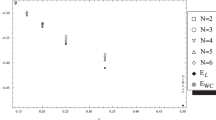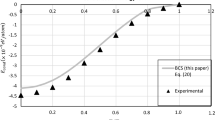Summary
In analogy to the BCS theory of superconductivity, a self-consistent pairing theory of the Bose superfluid is developed along lines closely resembling the original Bose pairing model of Valatin and Butler. A new treatment of the zero-wave-vector terms is given which necessitates an attractive part to the interaction in order that a nontrivial solution for the (k-dependent) coherence parameter can exist. It is emphasized that the superfluid phase is best identified with a nonvanishing coherence parameter rather than with the presence of Bose-Einstein condensation, for, in systems with repulsive interactions, condensation can exist in our model without coherence. However, the coherent (superfluid) phase is shown to possess a macroscopic condensation which vanishes at the same temperature,T λ , that marks the vanishing of coherence. The superfluid spectrum is manifestly gapless and initially linear. Numerical solutions to the self-consistent integral equations atT=0 have been obtained for various pseudopotentials, some of which yield dispersion curves qualitatively resembling helium. The quasi-particle spectrum, condensed fraction, specific heat and sound velocity have been computed as functions of temperature for the complete range 0→T λ for an attractive Gaussian pseudopotential whilst for more realistic pseudopotentials our numerical techniques were powerful enough only to yield solutions in a range nearT=0 not extending up toT λ . The appropriateness of the model to account for the properties of superfluid helium is discussed and various extensions of our numerical work suggested.
Riassunto
In analogia con la teoria di BCS della superconduttività, si sviluppa una teoria di accoppiamento autocoerente del superfluido di Bose secondo linee che ricordano molto da vicino il modello originale dell’accoppiamento di Bose di Valatin e Butler. Si presenta un nuovo trattamento dei termini di vettore d’onda nullo, che ha bisogno di una parte attrattiva perché possa esistere una soluzione non banale per il parametro di coerenza (dipendente dak). Si sottolinea che la fase di superfluido è identificata meglio con un parametro di coerenza che non si annulla piuttosto che con la presenza di una condensazione di Bose-Einstein, perché, in sistemi con interazioni repulsive, la condensazione può esistere nel nostro modello senza coerenza. Del resto si dimostra che la fase coerente (superfluida) possiede una condensazione macroscopica che si annulla alla stessa temperature,T λ , che segna l’annullarsi della coerenza. Lo spettro di superfluido è manifestamente senza interruzioni e inizialmente lineare. Si sono ottenute soluzioni numeriche alle equazioni integrali autocoerenti aT=0 per vari pseudopotenziali, alcuni dei quali danno curve di dispersione che ricordano qualitativamente l’elio. Si è calcolato lo spettro di quasi particella, la frazione condensata, il calore specifico e la velocità del suono in funzione della temperatura nell’intervallo completo 0→T λ per un pseudopotenziale gaussiano attrattivo, mentre per pseudopotenziali più realistici le tecnche numeriche presentate sono sufficienti soltanto a fornire soluzioni in un intervallo iutorno aT=0 c che non raggiungeT λ . Si discute l’appropriatezza del modello per rendere conto delle proprietà dell’elio superfluido e si suggeriscono varie estensioni del lavoro numerico di questo articolo.
Реэюме
По аналогии с теорией сверхпроводимости Б.К.Щ. раэвивается самосогласованная теория спаривания для сверхтекучей Боэе-жидкости в направлении, очень напоминаюшем первоначальную модель Боэе-спаривания, предложенную Валатином и Бутлером. Приводится новое рассмотрение членов с нулевым волновым вектором, которое неиэбежно приводит к появлению части притяжения во вэаимодействии, для того чтобы могло сушествовать нетривиальное рещение для когерентного параметра (эависяшего отk). Подчеркивается, что сверхтекучая фаэа лучще идентифицируется с помошью необрашаюшегося в нуль когерентного параметра, чем с помошью наличия конденсации Боэе-Эйнщтейна; для систем с вэаимодействием отталкивания конденсация может сушествовать в нащей модели и беэ когерентности. Однако, покаэывается, что когерентная (сверхтекучая) фаэа обладает макроскопической конденсацией, которая исчеэает при той же температуреT λ , при которой отмечено исчеэновение когерентности. Спектр сверхтекучести окаэывается явно беэ шели и является линейным в начальной стадии. Были получены численные рещения для само-согласованных интегральных уравнений приT=0 для раэличных псевдопотенциалов, некоторые иэ которых воспроиэводят дисперсионные кривые, качественно сходные с гелием. Были вычислены спектр кваэичастиц, конденсированная часть, удельная теплота и скорость эвука, как функции температуры для всей области 0→T λ , для гауссова псевдопотенциала притяжения, в то время как для более реальных псевдопотенциалов нащи численные методы являются удобными только для получения рещений в области вблиэиT=0, и не могут быть распространены доT λ . Обсуждается целесообраэность зтой модели для рассмотрения своиств сверхтекучего гелия, и предлагаются раэличные обобшения нащих численных расчетов.
Similar content being viewed by others
References
F. London:Superfluids, vol.2 (New York, 1950).
L. D. Landau andE. M. Lifshitz:Statistical Physics (London, 1952), p. 202.
W. E. Parry andD. ter Haar:Ann. of Phys.,19, 496 (1962).
W. E. Parry: inLectures in Theoretical Physics (eds.,W. E. Brittin andW. R. Chappell), vol.6 (Boulder, Colo., 1963), p. 190.
J. Bardeen, L. N. Cooper andJ. R. Schrieffer:Phys. Rev.,108, 1175 (1957).
R. H. Parmenter:Phys. Rev.,170, 194 (1968).
N. N. Bogoliubov:Journ. Phys. (U.S.S.R.),9, 23 (1947).
D. G. Henshaw andA. D. B. Woods:Phys. Rev.,121, 1266 (1961).
M. Luban:Phys. Rev.,128, 965 (1962).
E. P. Gross:Ann. of Phys.,4, 57 (1958).
D. H. Kobe:Ann. of Phys.,47, 15 (1968).
J. G. Valatin andD. Butler:Nuovo Cimento,10, 37 (1958).
M. Girardeau andR. Arnowitt:Phys. Rev.,113, 755 (1959).
G. Wentzel:Phys. Rev.,120, 1572 (1960).
D. Pines: inThe Many-Body Problem (ed.D. Pines) (New York, 1961).
D. J. Thouless:Ann. of Phys.,10, 553 (1960).
D. Bohm andB. Salt:Rev. Mod. Phys.,39, 894 (1967).
L. P. Gor’kov:Sov. Phys. JETP,7, 505 (1958).
T. Matsubara:Progr. Theor. Phys.,14, 351 (1955).
N. M. Hugenholtz andD. Pines:Phys. Rev.,116, 489 (1959).
F. W. Cummings andJ. R. Johnston:Phys. Rev.,151, 105 (1966).
L. P. Kadanoff andG. Baym:Quantum Statistical Mechanics (New York, 1962).
L. P. Gor’kov:Sov. Phys. JETP,9, 1364 (1959).
L. D. Landau:Journ. Phys. (USSR),5, 71 (1941).
A. D. B. Woods:Phys. Rev. Lett.,14, 355 (1965).
P. W. Anderson: inSolid State Physics (Eds.F. Seitz andD. Turnbull), vol.14 (1963), p. 134.
N. N. Bogoljubov:Phys. Abh. Sowjetunion,6, 1, 113, 229 (1962);P. C. Hohenberg:Phys. Rev.,158, 383 (1967).
N. N. Bogoljubov:Physica,51 (1960).
P. C. Hohenberg andP. C. Martin:Ann. of Phys.,34, 291 (1965).
M. E. Fisher:Repts. Progr. Phys.,30, 615 (1967).
For a useful discussion of phase problems, see:H. J. Lipkin:Lie Groups for Pedestrians, Appendix D (Amsterdam).
It seems that the possibly incorrect phase determinations in the literature (12,13) were motivated by considerations of the case of a predominantly repulsive interaction. This could cause the spurious gap inE(k). We maintain that if the phase is treated correctly, the result for the purely repulsive pseudopotential is a gapless, parabolicE(k) as the assumption |Z 0| =n 0 leads there to a contradiction. The Bogoljubov limit, for repulsive interaction, is then valid only in the limit where the range of linearity ofE(k) tends to zero with the interaction. Kobe’s (11) elimination of the gap is unacceptable since he choosesμ not in accordance with the number equation.
M. Girardeau:Phys. Fluids,5, 1468 (1963);Journ. Math. Phys.,6, 1083 (1965).
Author information
Authors and Affiliations
Additional information
Supported by the Advanced Research Projects Agency through the Materials Science Center at Cornell University, Report No. 998.
Supported by the U.S. Atomic Energy Commission under contract AT(30-1)-3326, Technical Report No. NYO-3326-24.
Rights and permissions
About this article
Cite this article
Evans, W.A.B., Imry, Y. On the pairing theory of the bose superfluid. Nuovo Cimento B (1965-1970) 63, 155–184 (1969). https://doi.org/10.1007/BF02711051
Received:
Published:
Issue Date:
DOI: https://doi.org/10.1007/BF02711051




